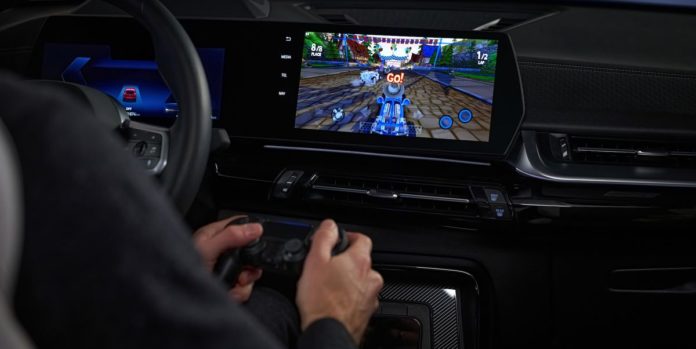- BMW’s new iDrive 9 infotainment system is adding more third-party apps, including video games that can be played with traditional Bluetooth controllers.
- The automaker also showed off its developmental remote-controlled valet parking at this year’s CES.
- BMW previewed other potential future technology too, including augmented-reality glasses.
Most people who have played video games on a console in the past 25 years have done so with a full-size controller. Later this year, they’ll be able to do the same in new BMW models with the iDrive 9 infotainment system. We had the opportunity to test that experience at this year’s CES, where BMW had live demonstrations of the soon-to-be-available feature as well as developmental tech that someday might become reality.
In-Car Video Games
It’s currently possible to play video games in several new BMW models with the AirConsole app that was introduced earlier this year. It lets people download games and use their smartphone as a controller—only when the car isn’t moving, of course. Before the end of 2024, BMWs with iDrive 9 will be able to play other video games with full-size controllers, including Bluetooth-enabled PlayStation and Xbox gamepads.
We had the chance to play Beach Buggy Racing 2 using a PlayStation 5 controller. While we only spent a few minutes playing during the demo, it was immediately clear that it was just as fun factor as playing on a normal device. The new BMW X1 we were in also had the benefit of an excellent audio system that made the sound experience extra enjoyable. The game can even be played in split-screen mode with a second controller.
BMW says the in-car gaming will be available through its ConnectedDrive Store along with a slew of other new third-party apps that are made possible by the Android-based software that’s baked into iDrive 9. Access requires paying for the BMW Digital Premium option, though. New models that aren’t initially available with the controller connection will be able to add it via an over-the-air update.
Remote-Controlled Valet Parking
Much stranger than playing a video game in a car is remotely controlling a real-life car using a driving simulator. That’s what we did at BMW’s outdoor exhibit at CES where we piloted an electric iX SUV through a parking lot course while seated about 100 feet away.
Facing a multiplex of screens and seated in a racing chair, we grabbed the steering wheel and placed our feet on the pedals. A video feed from the forward-facing camera was our primary view, but it didn’t provide a sense of spatial awareness. A secondary screen to our right showed an overhead view that helped us navigate between the cones and the gates that served as checkpoints.
We’re not strangers to driving simulators, but remotely driving the iX with one was a much different experience due to the delays between our inputs and the actual acceleration and braking. Getting the EV SUV to go required flattening the accelerator pedal and waiting a few seconds before the vehicle started to move. Even then, its top speed was limited to 15 mph, which is also the posted speed limit for most parking lots and parking garages.
Just like a production model, our iX RC car is able to park itself in certain situations. BMW—which developed the remote-controlled valet with the help of Valeo, a mobility-focused tech company—said the idea is for drivers to leave their vehicle at a designated dropoff spot and then for it to automatically search for an open spot and return to the pickup point when summoned. Of course, the Level 4 automated parking system can also be remotely controlled in the way that we experienced. Someday, this technology could be used for events big and small as well as by logistics companies.
AR In a Car
While we didn’t have time to experience them, BMW also held live demonstrations of its augmented-reality glasses. Called “XREAL Air 2,” the AR lenses are designed to provide the driver and passengers with information that’s supplementary to the vehicle’s standard displays.
The demonstration is described as a trip through Las Vegas where navigation, hazard information, points of interest, and entertainment content are shown via the AR glasses. BMW believes this technology will become more common in the coming years, and it has been following the development as far back as 2008.
In 2015, the company previewed an augmented-reality system with the Mini Augmented Vision project. More recently, this author drove a real-life BMW M2 around a racetrack wearing a virtual-reality headset. Clearly, BMW is invested in this tech, which suggests it might be closer to reality than fantasy.
Eric Stafford’s automobile addiction began before he could walk, and it has fueled his passion to write news, reviews, and more for Car and Driver since 2016. His aspiration growing up was to become a millionaire with a Jay Leno–like car collection. Apparently, getting rich is harder than social-media influencers make it seem, so he avoided financial success entirely to become an automotive journalist and drive new cars for a living. After earning a journalism degree at Central Michigan University and working at a daily newspaper, the years of basically burning money on failed project cars and lemon-flavored jalopies finally paid off when Car and Driver hired him. His garage currently includes a 2010 Acura RDX, a manual ’97 Chevy Camaro Z/28, and a ’90 Honda CRX Si.



